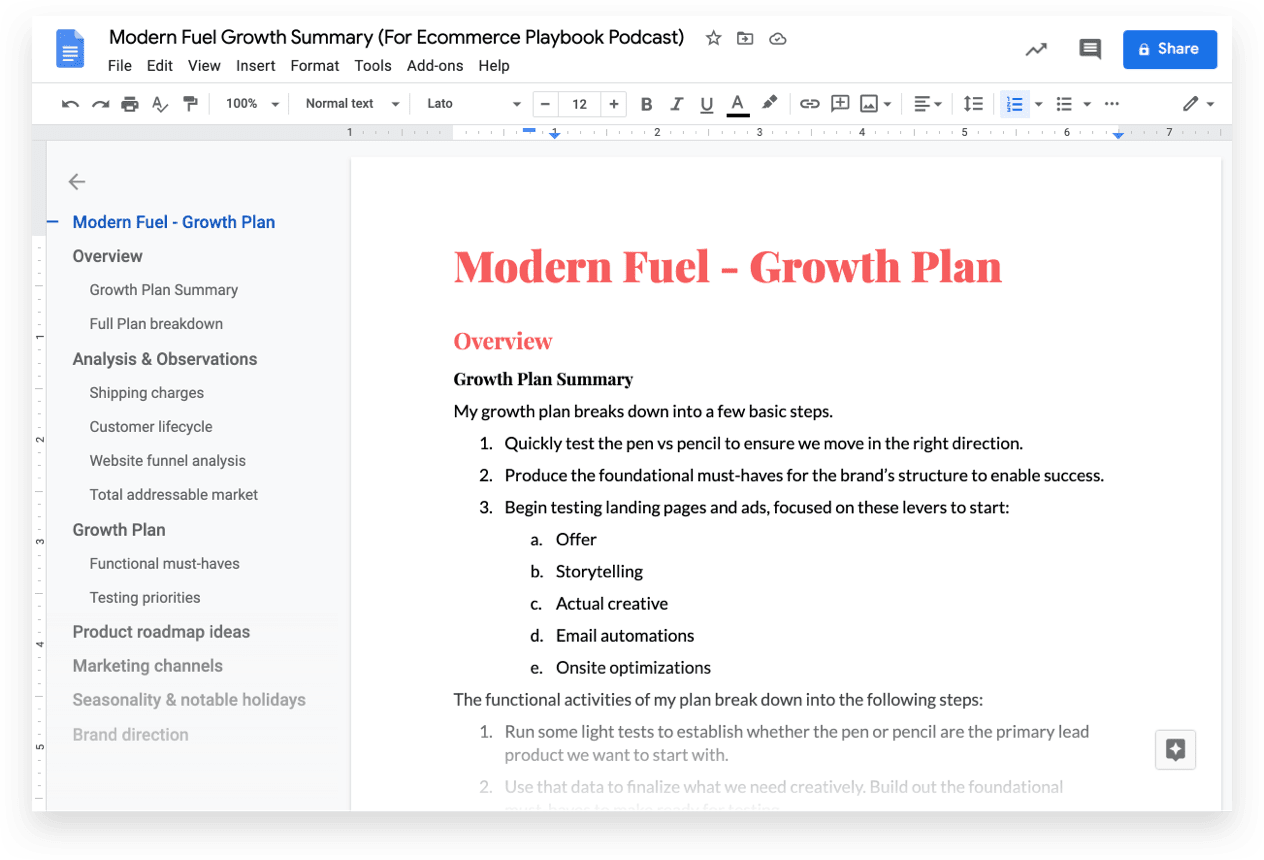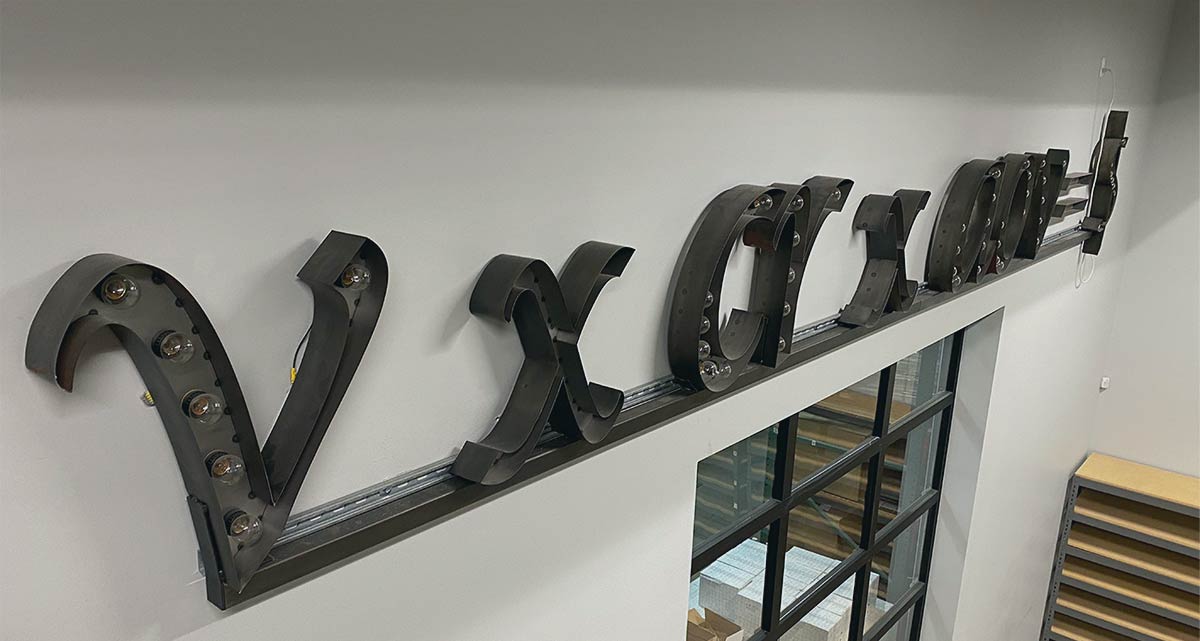
How do you develop an ecommerce marketing strategy?
Traditional marketing plans center on the five Ps: product, price, promotion, place, and people. While helpful, strategies anchored in them typically lead to “templates” with little more than a grab-bag of tactics, best practices, and isolated channels.
Instead, you need a formula. Literally an ecommerce growth equation to create a unified, profit-generating system.
That’s exactly what you’ll find below …
10 ecommerce marketing strategies organized around 5 variables that equal profit:
- Prioritize a Healthy Traffic Mix of Paid and Organic
- Create Separate Funnels by SKU or Buyer Personas
- Follow AIDA Metrics to Improve Creative Performance
- Optimize for the Conversion Objective (Always? Yes, Always)
- Capture Demand through Search Engine Marketing
- Win via Content Marketing and Search Engine Optimization
- Set Source-Specific Conversion Benchmarks & Goals
- Hone Your Offer, Your Whole Offer, & Almost Nothing But Your Offer
- Accelerate LTV via Email Marketing, SMS, and First Purchase
- Manage Variable Costs By Dividing Them into Four Categories
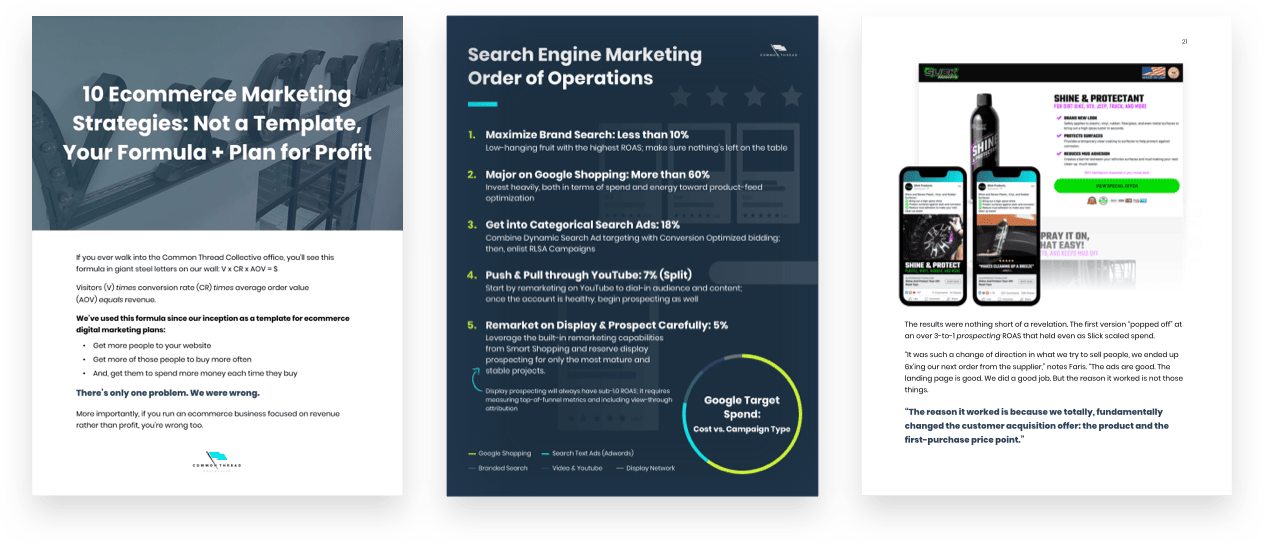
Let’s start with a confession …
If you ever walked into Common Thread Collective, you’d have seen this formula in giant steel letters.
V x CR x AOV = $
Visitors (V) times conversion rate (CR) times average order value (AOV) equals revenue.
- Get more website visitors to your store
- Get more of those people to buy more often
- And, get them to spend more money each time they buy
There’s only one problem. We were wrong. If you run your ecommerce business focused on revenue rather than profit, you’re wrong too. Here’s our CEO, Taylor Holiday, explaining why …
The Right Formula Equals a Marketing Strategy for Profit
First, instead of Visitors (V) in general — or even paid visitors through Facebook — what matters is a healthy mix: demand generation, demand capture, and demand retention.
Second, sitewide Conversion Rates (CR) tell you nothing. That’s why you’ll need to invest in specific funnels, creative consistency, and the almighty offer.
Third, rather than AOV, your real focus has to be on accelerating Lifetime Customer Value (LTV) over tight timeframes.
We call it your Cash Multiplier. It includes AOV but extends throughout the funnel to identify and maximize your most-profitable customers.
Fourth, with margins shrinking, no ecommerce marketing plan is complete without Variable Costs (VC). If you don’t have strong bookkeeping and a detailed marketing budget, here we’ll unpack accounting principles plus a few tactics to increase efficiency.
Fifth and finally, we’ll tie everything back together around profit. Actually … there’s more to it. The thing we’ll truly focus on is uniting all your marketing channels under a single profit-generating system.

Part 1. Visitors: Increase Your Traffic, Marketing Channel Mix & Creative Performance
Every variable is an opportunity for improvement. Tactically, it always starts with traffic.
If you don’t have enough traffic, you’re dead in the water. Likewise, if you don’t have the right traffic mix.
- Paid social media: 25%-50%
- Organic search: 20%-25%
- Paid search (SEM): 20%
- Email list: 15%-20%
- Other: 10%-15%
1. Prioritize a Healthy Traffic Mix of Paid and Organic
Begin by benchmarking your overall channel attribution (via Google Analytics or Statlas) against two stages of DTC development:
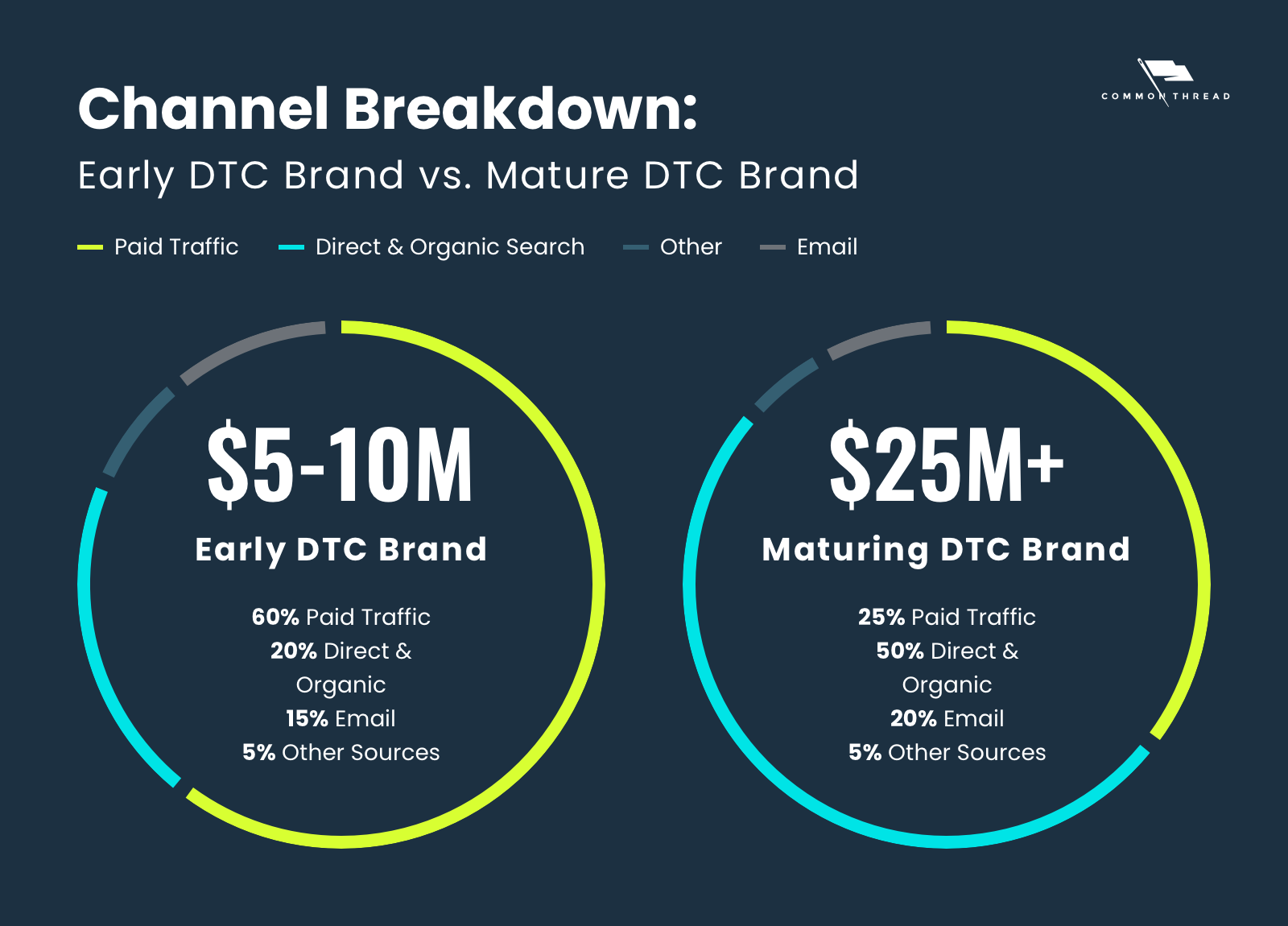
When we think about visitors, Facebook is still the star of the show. Not because we’re a Facebook ad agency; rather, because Facebook is the core driver of new growth for ecommerce websites.
We’ve written before about diversification being a dangerous ecommerce trend — a siren song that’s led many businesses onto the rocks. Absolutely try other channels and stay keenly aware that what worked yesterday isn’t necessarily what’s going to work tomorrow.
Nonetheless, Facebook remains the single most-powerful demand generation platform in the history of commerce.
Next, we use search engine marketing (SEM) to make sure that the client “owns their real estate”: the top results for branded searches. Google ads versus Facebook ads shouldn’t be pitted against each other; but instead, united.
Only after demand generation via social media platforms and demand capture via search — namely, Google Shopping and Google Ads — are in place do we then turn our attention to diversification on other platforms like Snapchat, Pinterest, and TikTok.
Let’s look closely at each one …
2. Create Separate Funnels by SKU or Buyer Personas
When you start on Facebook, you have zero pixel data. You have to “aim” or “season” your pixel through narrow targeting. As your pixel data begins to aggregate — you can use broad audiences, which essentially means lookalike audiences.
You’re telling Facebook, “Hey, use my pixel data to go find more potential customers just like my current customers. People (target audience) who will buy this thing (product) at this price (offer) for this reason (creative).”
Unfortunately, you’ll eventually hit a saturation point. Facebook can only find so many new customers like your previous customers. Once that happens, efficiency drops.
When you hit a wall, you need to bring back specificity to unlock new audiences and scale.
To do this, you have to re-aim the pixel through new creative strategies and new funnels to attract new customers while still keeping broad audiences.
In other words, scale comes from precision … not breadth.
Replace half-hearted attempts at segmentation with entirely separate funnels for each product or audience.
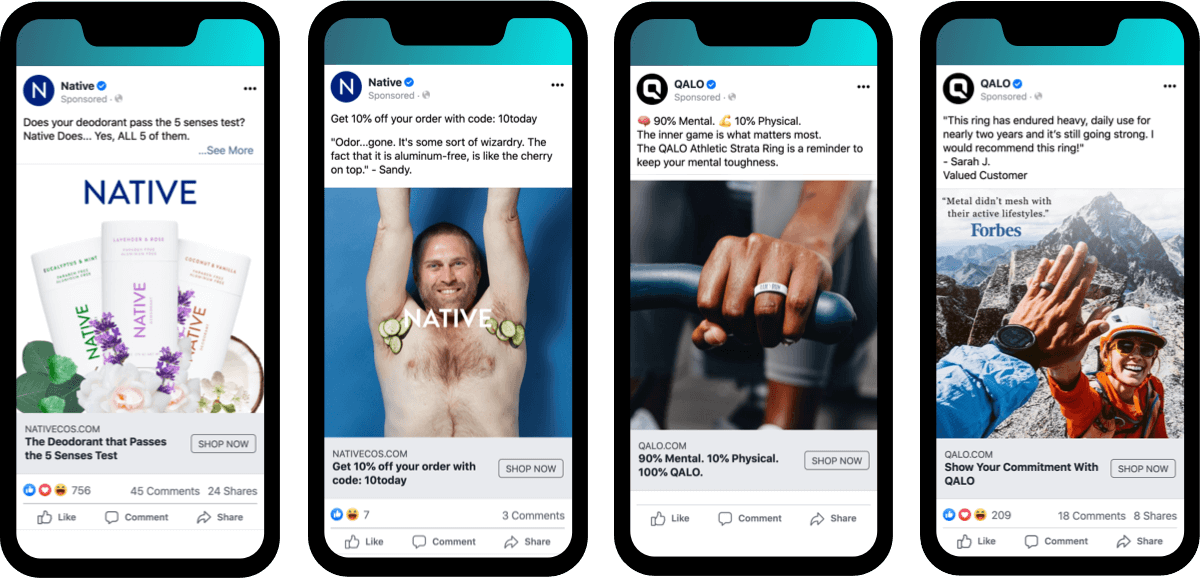
At risk of stating the obvious, the type of creative and messaging that resonates with a 20-year-old man is often quite different from that of a 50-year-old woman.
The reasons that an outdoorsy couple chooses to purchase a silicone wedding ring are going to be much different than the reasons a CrossFit couple opts for the same exact ring.
The secret to scaling isn’t to simply reach a broader audience. It’s to target more customer segments.
3. Follow AIDA Metrics to Improve Creative Performance
There are a lot of variables at play in a Facebook ad campaign. The AIDA framework helps make sense of them and systematically improve ad performance:
- Attention
- Interest
- Desire
- Action
All too often, ecommerce businesses run campaigns where 90% of their ad spend is wasted on scrolls — viewers who aren’t even pausing to watch the ad for a handful of seconds.
Attention always comes first: three-second video view divided by impressions.
Set a minimum goal of 25%-30% of your audience to stop and view the ad. If not, revisit your ads’ first three seconds.
In fact, we have target metrics for each stage of the AIDA framework, which you can view below:

To drive results, you must go in order.
Make sure you’re grabbing Attention first. When you have Attention, make sure you are holding viewers’ interest. If both Attention and Interest are being met, evaluate Desire. Then, Action.
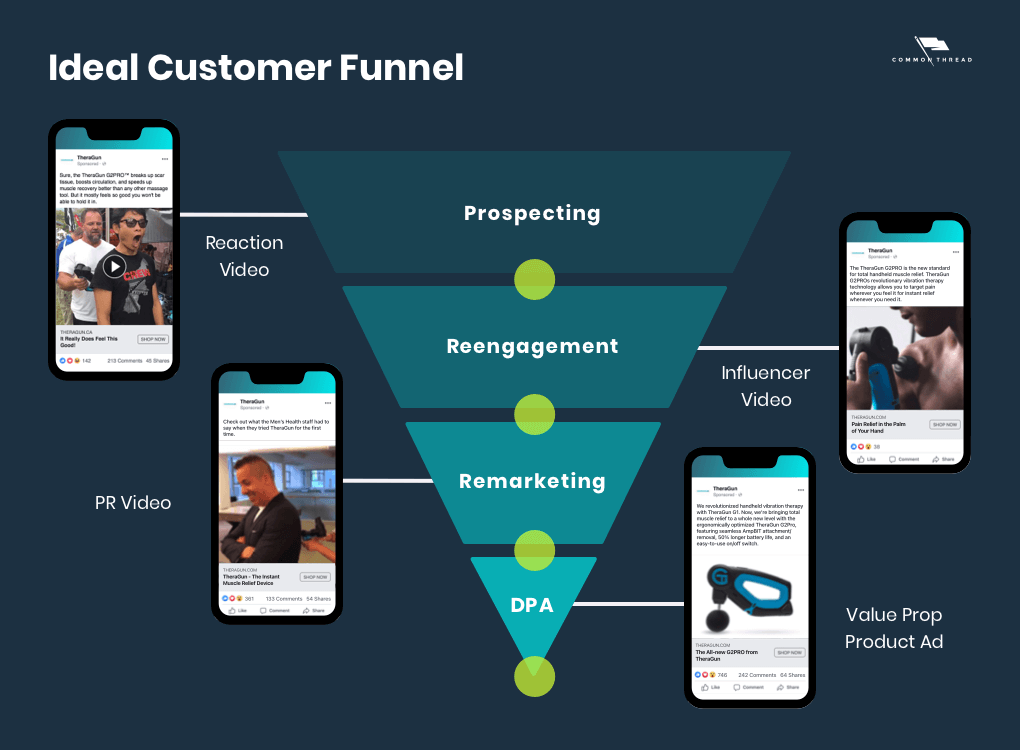
4. Optimize for the Conversion Objective (Always? Yes, Always)
This is a simple point, but important enough it deserves it’s own header. At CTC, we always, always bid for the conversion objective.
Bidding for top of the funnel metrics related to “Brand Awareness” or middle of the funnel actions like “Add to Shopping Cart” or “Initiate Checkout” to season the pixel can be seductive.
Don’t.
By doing this, you’re telling Facebook to go find people who will Add to Shopping Cart or Initiate Checkout, but who won’t ultimately convert.
I doubt you want people like that clogging up your funnel — even less do you want window shoppers, who start buying … but often leave you with an abandoned cart.
5. Capture Demand through Search Engine Marketing
Facebook dominates demand-generation. Google Ads and Shopping owns demand-capture. The first thing that many people do when they see an ad is go to Google search and look up the brand.
It’s critical to “own your own real estate”: maintaining control over what people see and find when they search for your brand.
The more competitive your landscape, the more important this becomes.

Maximizing brand search is the very first step to take in your order of operations. But search-engine marketing doesn’t end there …
Search Engine Marketing Order of Operations
1. Maximize Brand Search: Less than 10%
Low-hanging fruit with the highest ROAS; make sure nothing’s left on the table
2. Major on Google Shopping: More than 60%
Invest heavily, both in terms of spend and energy toward product-feed optimization
3. Get into Categorical Search Ads: 18%
Combine Dynamic Search Ad targeting with Conversion Optimized bidding; then, enlist RLSA Campaigns
4. Push & Pull through YouTube: 7% (Split)
Start by remarketing on YouTube to dial-in audience and content; once the account is healthy, begin prospecting as well
5. Remarket on Display & Prospect Carefully: 5%
Leverage the built-in remarketing capabilities from Smart Shopping and reserve display prospecting for only the most mature and stable projects. Display prospecting will always have sub-1.0 ROAS; it requires measuring top-of-funnel metrics and including view-through attribution
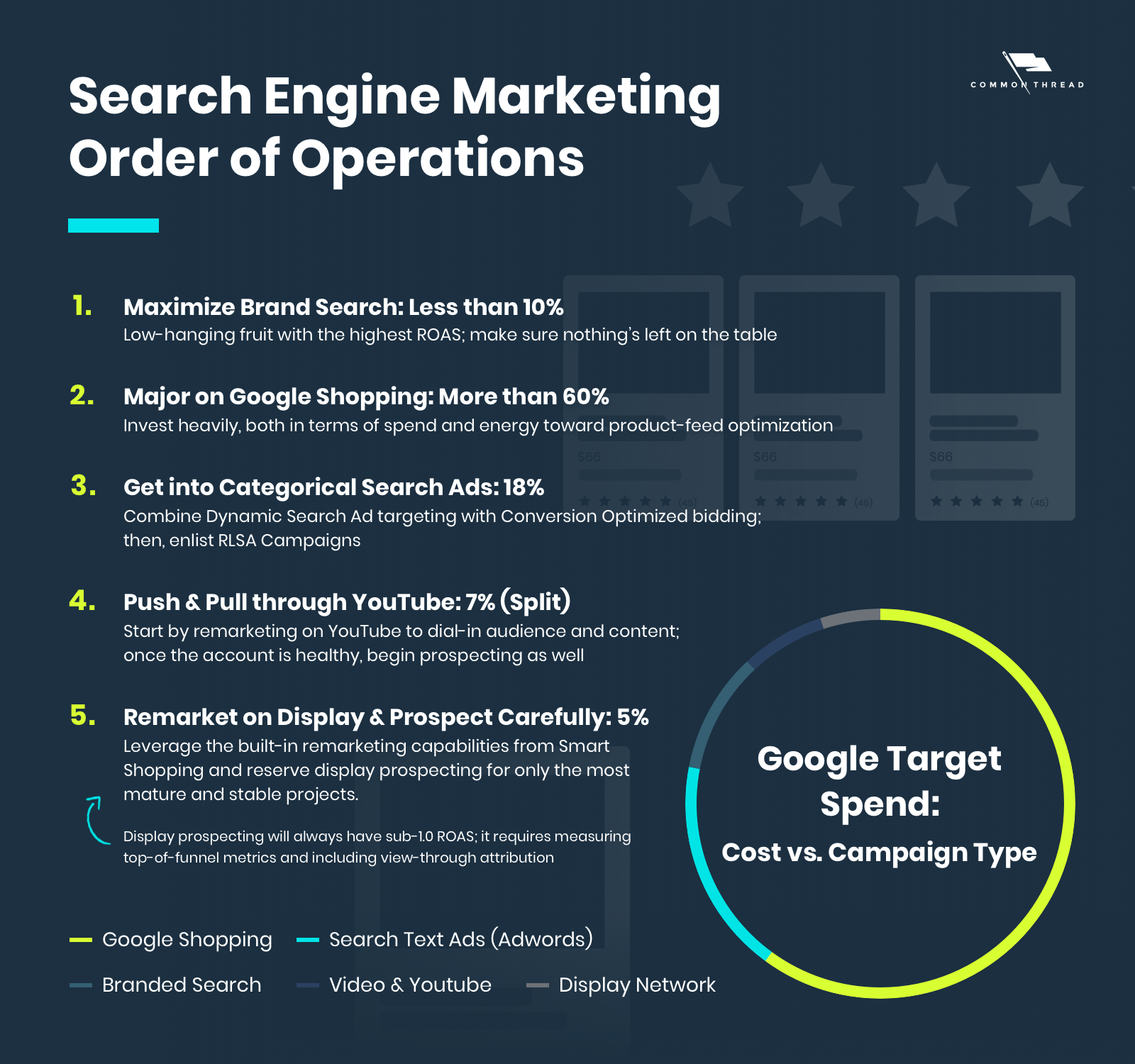
Two-thirds of all PPC click-throughs on Google go to product listing ads (PLAs), also known as Google Shopping Ads or Smart Shopping Campaigns.
Unfortunately, most budgets dramatically underspend on this prime and high-intent ad space. Worse, rather than optimize product feeds to display buying triggers — like reviews, custom images, discounts, shipping, and more — data gets abandoned to its default setting.
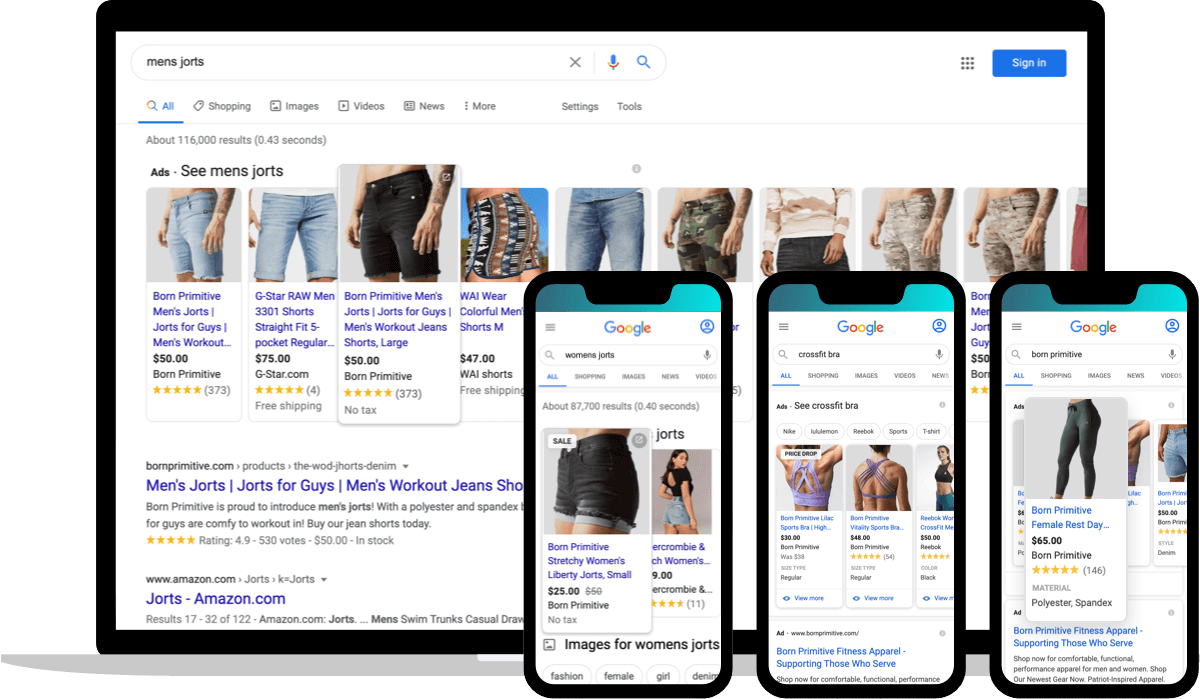
Still, the real key to scaling search engine marketing goes beyond search.
It’s a full-funnel approach that infuses your best creative into digital channels like YouTube and display advertising. It also requires measuring blended ROAS using a North Star metric like marketing efficiency ratio (MER).
Customizing content for placement and performance unleashes your brand everywhere customers turn.
Google calls this new shopping behavior the “messy middle.” We call it the “brand lasso” — uniting demand generation with demand capture:

6. Win via Content Marketing and Search Engine Optimization (SEO)
If an ecommerce brand makes it to three years, we can pretty much guarantee that they’ve either succeeded with Facebook ads or experienced some viral moment that jump-started sales.
If an ecommerce brand makes it to 10 years, then they have very likely succeeded at content marketing as well — i.e., organic traffic.
Content and commerce is a slow-burn, long-term play.
For some brands, search volume will allow them to scale to tens of thousands — if not hundreds of thousands — of qualified shoppers per month through search engine optimization (SEO).
To do that requires a combination of three factors.
One, optimizing your collection and product pages for high-buying-intent keywords. Two, optimizing those same pages for technical considerations — chiefly, correct H tags, alt image tags, and load speed. Three, producing additional relevant content for non-buying-intent keywords.
Not every product comes with a lot of search intent. Successful content marketing for other niches can include:
- User-generated content (UGC)
- Contests and challenges
- Organic social media presence
- Influencer marketing and collaborations
- Micro-influencer content production
- YouTube and other video platforms
- Affiliate marketing and lead generation
- Product descriptions and customer reviews
Organic content costs less than paid for each marginal visitor — it’s an upfront investment offset by reduced CAC, more customer loyalty, and a much longer ROI window.
None of that, however, is why content truly matters.
As our VP of Marketing, Aaron Orendorff, puts it: “The power of content lies in entering an audience’s heart and mind through a consistent story well told; one with people, not products, at its core.”
A high-quality content strategy gives your brand a reservoir of assets for every other type of marketing this template mentions. From ads to email, acquisition to retention, content has become a moat.
One that will only widen in the years to come, separating winners from losers.
Part 2. Conversion Rate: Optimize Your Funnels, Creative & the (Almighty) Offer
Ecommerce isn’t unique when it comes to conversion rate optimization (CRO).
That said, we don’t typically find that going through an extensive, sitewide CRO process brings in a notable return for our clients.
Instead, we focus primarily on assets that make up our core Facebook ad funnels. Why? Because the lessons from paid traffic are rapidly testable and more widely applicable to other sources.
In the same way, your plan should monitor each metric within your flywheel — paid and organic — looking for weak points or opportunities for improvement to inform creatives.
7. Set Source-Specific Conversion Benchmarks & Goals
Pulling from Google Analytics, two evaluations stand out.
First, a simple table or spreadsheet detailing your conversion rate by channel. Second, a conversion rate versus average order value (AOV) scatter plot.
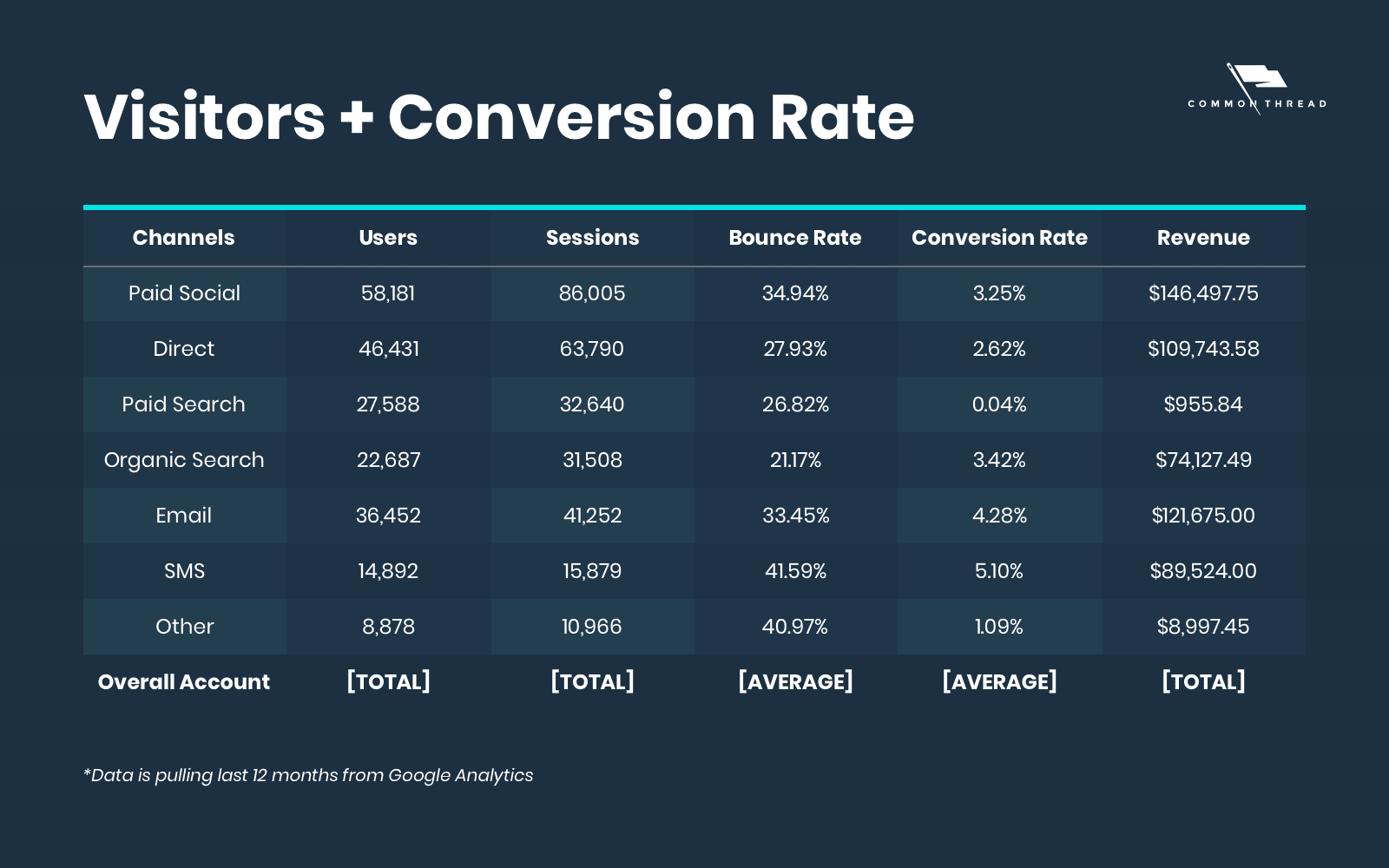
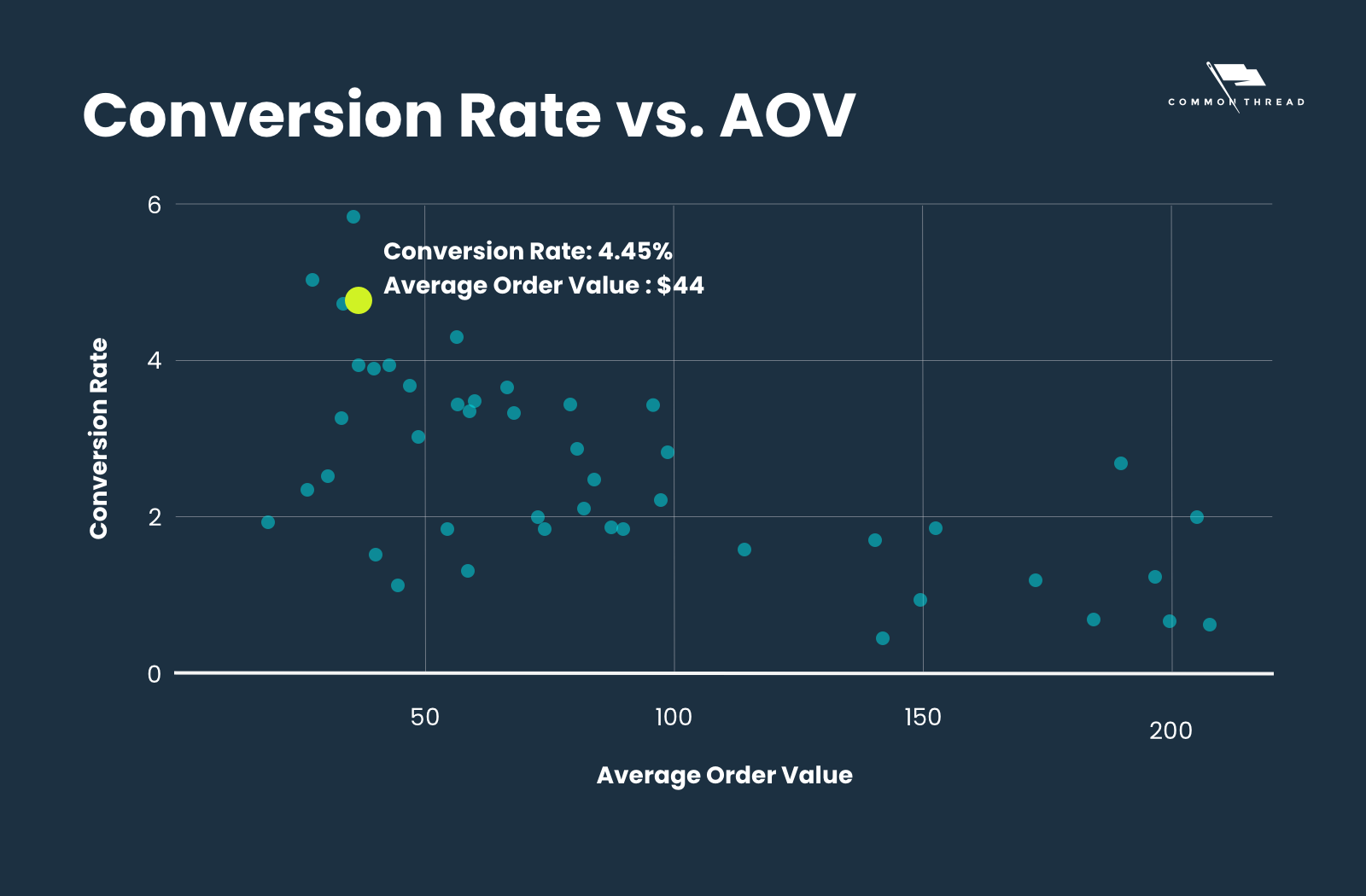
These data points also exist in Statlas (our in-house tool made specifically for ecommerce brands). Enabling our clients to view the same valuable information while also comparing and benchmarking their brand against over 200 DTC stores.

While conversion rate optimization (CRO) for ecommerce isn’t much different than in any other industry, we approach it in a very specific way.
When most people talk about CRO, they are talking about sitewide conversions.
At CTC, we zero in on social-media marketing campaigns to an almost compulsive level.
Mastering paid traffic lets you apply those same lessons on easier-to-convert sources like organic, direct, referral, and email. You can also test paid traffic faster and more accurately than other sources because you’re in control of all the levers.
We use AIDA to evaluate funnel performance from ad to site, but that’s just the beginning.
The job of an ad, in its simplest form, is to get someone off of Facebook and onto the ecommerce site. From there, it’s the ecommerce store’s duty to convert.
To improve conversion rates, we utilize Message Mapping.
Message Mapping ensures that a customer who sees your ads sees the same message as they continue forward in the funnel — copy, creative, aesthetics, and offer.

We want consistency from the ad all the way through the purchase.
Does the experience flow seamlessly from
- Ad to landing page
- Landing page to cart
- Cart to checkout process
- Confirmation page to post-purchase emails
- And right through to the product’s unboxing experience?
Nothing creates a worse user experience than clicking an ad for a specific product and being dumped onto a generic page where the user needs to hunt for that product.
While this might sound like common sense, many ecommerce businesses have abandoned this work-intensive process in their desire to scale quickly.
Five years ago, it might have worked, but with ad costs rising dramatically, this method of scaling won’t cut it.
We find that conversion improvements fall into one of these buckets:
- Improving consistency
- Improving copywriting
- Improving layout
- Improving timing
- Improving cross selling
Consistency rules for a reason. You likely have elements of segmentation in your ads.
Without consistency through the entirety of the funnel, that can actually hurt performance even more than if there were no elements of segmentation at all.
When the message is focused and consistent from start to finish, the conversion problems will often work themselves out.
8. Hone Your Offer, Your Whole Offer & Almost Nothing But Your Offer
Offer doesn’t mean discount. Rather, your offer is the sum total of two ingredients: product and price.
We might add another “P” — how you position product and price (i.e., your creative) — but, honestly, that only muddies the water until you nail the first two.
It’s impossible to overstress the centrality of what you offer shoppers (product) coupled with the cost of buying it (price). This is the main event … and where the bulk of onsite conversion efforts should take place.
Naturally, tons of variables affect your funnels. We’ve covered many of them already. In terms of performance, they’re sideshows compared to the offer.
To illustrate, consider Slick Products — a brand formerly operated by CTC.
Slick specializes in wash products for off-road vehicles. Shipping heavy bottles of liquid makes low-AOV purchases disastrous to margins. As a result, it exclusively drives traffic to kit landers to bundle multiple new products in each order.
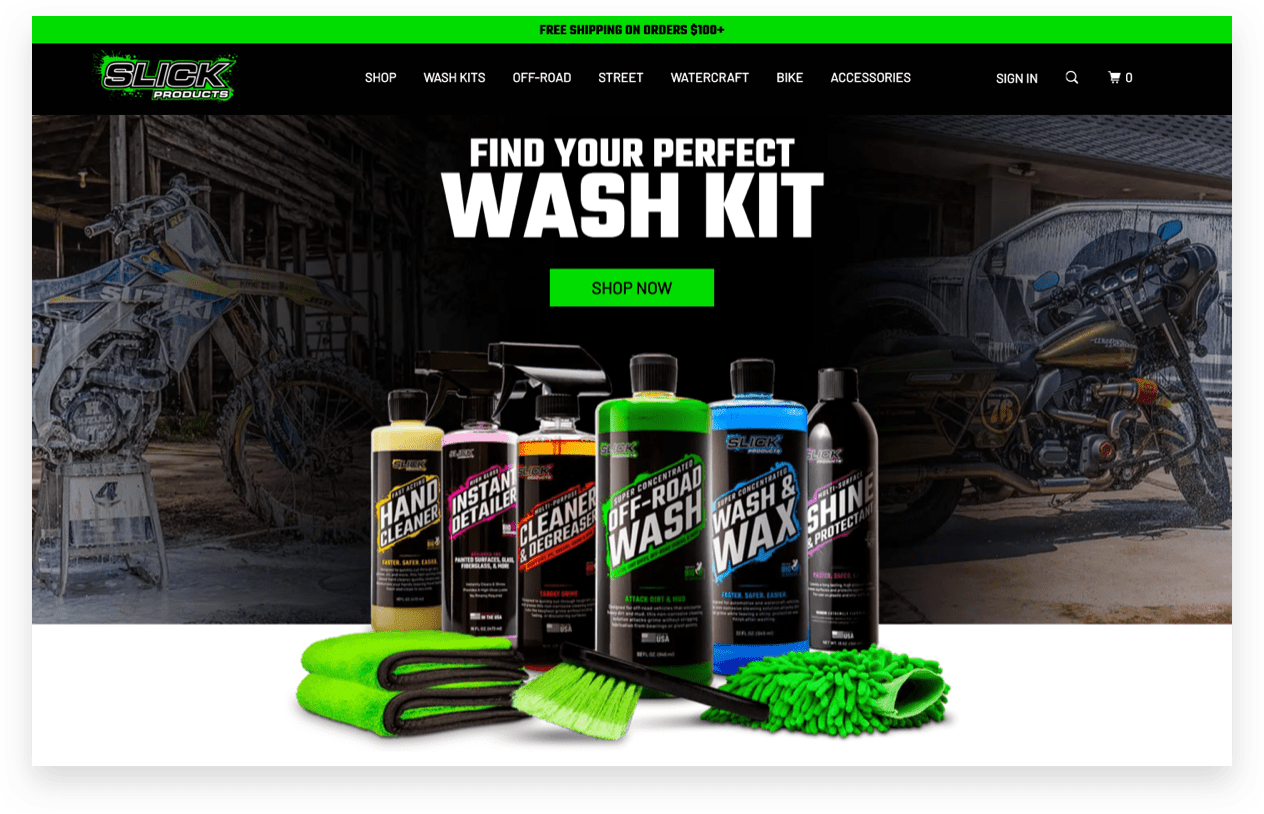
Or rather … it did.
“What we realized is that people love the shine product; it’s the one part of the kits we get the most comments on,” says Andrew Faris, former CEO of 4x400, which owned Slick beneath CTC as a parent company.
“So we thought, ‘What if — instead of trying to sell the whole kit and explain everything about why this is the best way to wash your vehicle — what if we just sell people on the shine?’”
The team decided to do exactly that: launch a new funnel that placed the shine front and center:
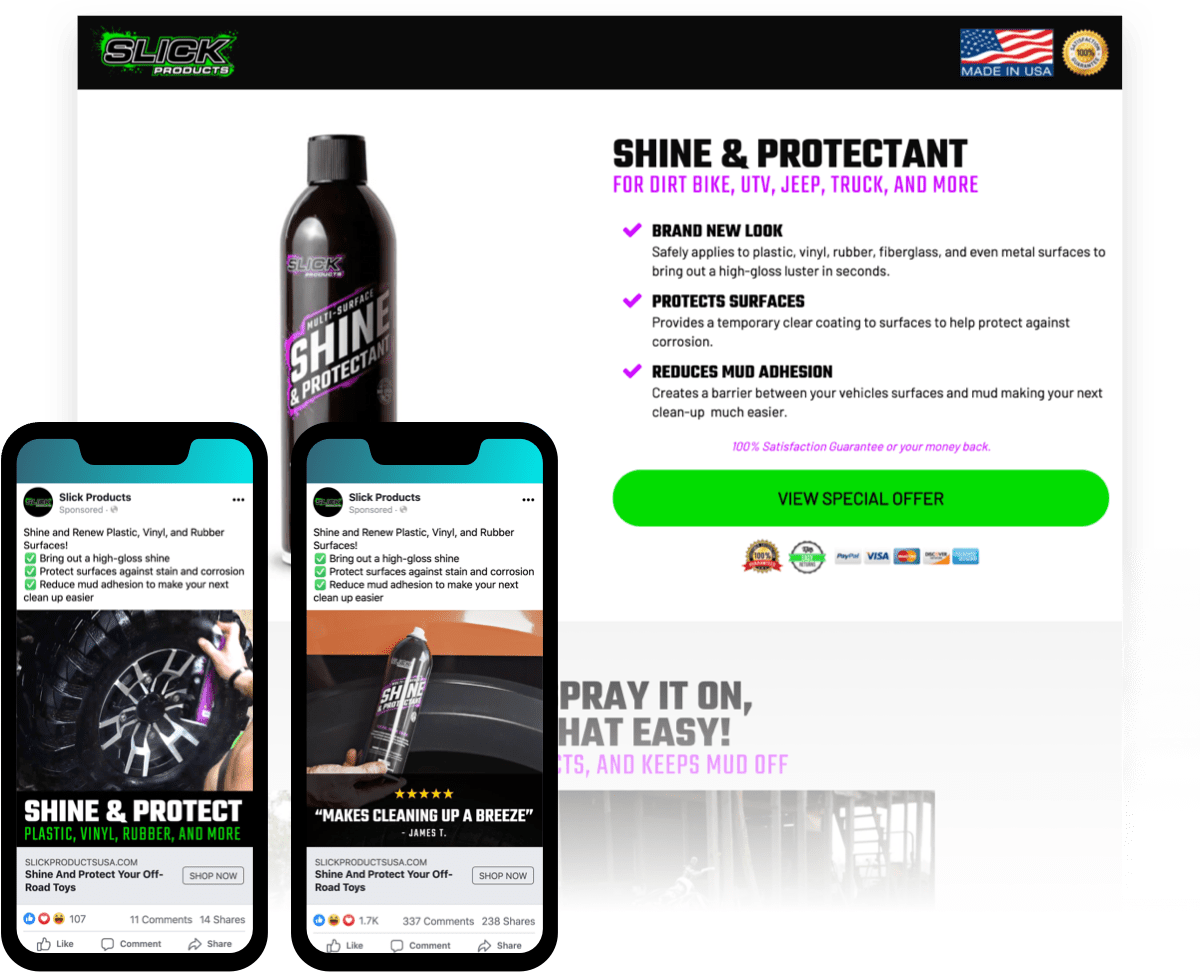
The results were nothing short of a revelation. The first version “popped off” at an over 3-to-1 prospecting ROAS that held even as Slick scaled spend.
“It was such a change of direction in what we try to sell people, we ended up 6x’ing our next order from the supplier,” notes Faris. “The ads are good. The landing page is good. We did a good job. But the reason it worked is not those things.
“The reason it worked is because we totally, fundamentally changed the customer acquisition offer: the product and the first-purchase price point.”
For more on the centrality of offers, check out three resources also from the 4x400 team:
- Stop Running Small Tests: From Faris’ Ecommerce Playbook Podcast where he narrates the shine revelation
- Effective Facebook Ad Campaigns: A step-by-step article on the same process at another CTC brand, Bambu Earth
- Modern Fuel Growth Summary: Created by David Rekuc, VP of New Brands at 4x400, this 19-page Google Doc goes behind-the-scenes on the actual strategy to grow its latest acquisition
Part 3. Customer Lifetime Value: Identify & Increase Your Cash Multiplier
For years, ROAS functioned as a proxy for online revenue or even money in your pocket. If ROAS was doing well, you were doing well.
Then, the digital marketing world changed.
Established ecommerce businesses are beginning to face what Uber marketer Andrew Chen calls “the law of shitty cohorts.” Over the last few years, we’ve seen a notable increase in customer acquisition costs (CAC) via Facebook as well as across the ecommerce landscape.
Some treat this as a paradigm shift.
However, all it really means is that margins are tightening, ecommerce businesses are having to pay more for their customers, and more competitors are entering the space.
You need to be able to adjust your ecommerce growth strategies to work under new parameters. How?
The trending answer to this problem in 2019 was to replace AOV with lifetime customer value (LTV). Unfortunately, traditional LTV has two fatal flaws:
- For startups and early-stage companies, LTV is a guess
- Even with hard data, online retailers — where cash-flow is king — will die waiting to realize the “lifetime” value of a customer
As a result, we came up with a different metric that we think does a better job of accomplishing what we want to accomplish with LTV while keeping it within an actionable time window.
‘Cash Multiplier’: A Better Way than LTV
While LTV is a nice buzzword for potential investors, most ecommerce businesses don’t have the luxury of waiting around for a “lifetime.” They’ll be long gone by the time LTV is fully realized.
Your businesses need cash flow within a much shorter time frame, and that’s why we’ve come up with a different metric that we think does a better job of accomplishing what we want to accomplish with LTV while keeping it within an actionable time window.
We call it the “cash multiplier” (CM); essentially, your 60-90 day LTV followed by the one-year mark.
To make those two time frames practical, aim for a 30:100 ratio — that is, aim to increase your brand’s CM by 30% in 60-90 days and by 100% in a year.
If you hit the first goal, then you know your product quickly found a place in your customer’s life and they came back for more. If CM hits 100% within a year, you know you’re building a brand that provides value, far more than the initial amount of money that they paid you.
Keep in mind that 60-90 days is an average.
You can adjust this window based on your business model, but to make things really simple, if you increase your 60-day customer value, you will increase your revenue and cash in your pocket.
The name isn’t really that important. What matters is understanding that your 60-90 day LTV, cash multiplier, or whatever you want to call it … will determine the ultimate success of all customer acquisition.
For example, let’s say your lavender deodorant results in the highest AOV at $12, but when you evaluate for CM data, you find that coconut vanilla deodorant results in a $20 CM, while lavender only yields a $15 CM.
Prioritizing coconut vanilla, both via your Facebook ads and your retention-focused remarketing will then increase your cash in pocket.
You’ve increased your revenue over a 60 or 90-day window, which is a more tangible benefit to your business than increasing either the average initial order value or the lifetime value of the customer.
For CTC clients, we carefully track cohorts through Statlas which makes it possible to track payback windows based on a variety of cohorts:
- Product by first purchase
- Time of purchase (seasonality)
- Acquisition channel, campaign, or specific offer

9. Accelerate LTV via Email Marketing, SMS, and First Purchase
No other digital marketing tactics have yet to outperform the online-sales power of email. Affordable, effective, and (with the right ingredients) personal.
A relatively new kid on the digital block, SMS gives email campaigns a run for their money. SMS gets your messages in front of consumers where they’re already spending their time.
Leveraging email and SMS in coordination yields more than the sum of their parts. SMS notifications for timely, action-oriented messages and email for visual storytelling and merchandising.
Failing to launch and optimize capture tactics for these two channels is akin to setting your money on fire. You might get that first conversion, but your repeat purchase rate will suffer without the ability to bring customers back again and again.
Utilizing a pop-up to collect email addresses and mobile numbers is the most effective way to build up your owned audience for future retargeting.
Critics of pop-ups will tell you they’re an intrusive interruption to the shopping experience. When done well, they can serve as a friendly invitation to stay in touch with a brand they’ve already expressed interest in.
The best pop-ups should …
- Greet the visitor and invite them to join your community
- Offer a moderate incentive for sharing their information
- Let them know what benefits they can expect from subscription

Keeping the messaging customer-centric drives high sign-up rates. Providing an incentive in exchange for their personal information greases the wheels for a same-session conversion.
But the real magic comes after the sign-up. If you’re unable to get that coveted first purchase right away, an effective welcome series nurtures prospects to purchase.
Sure, the flow should reiterate the incentive from your pop-up, but this series can also educate new subscribers about the “why” behind your brand and share more about your product assortment.
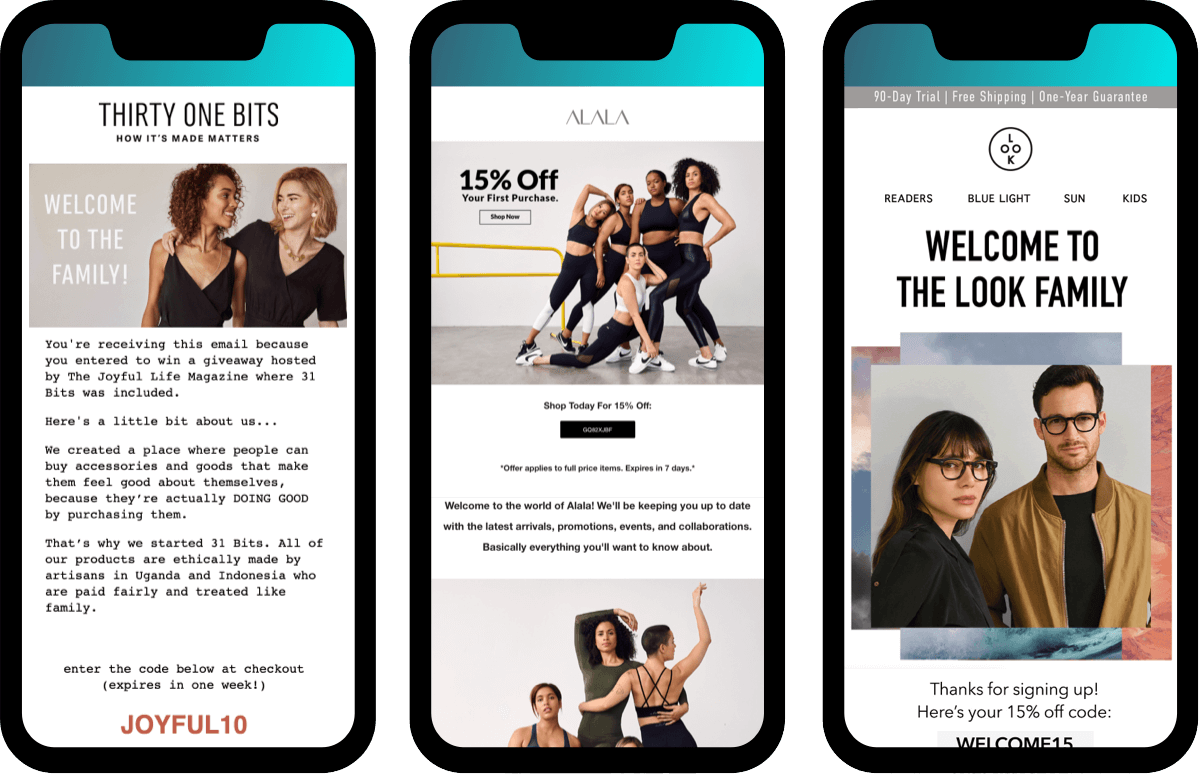
Merchandise these emails with your top-sellers along with the products that are most likely to drive repeat purchases. Getting the first purchase is not the end goal; instead, it’s the jumping-off point of a more serious relationship with your customer base.
As much as we want to believe our products alone should be a driver of retention, customers have a myriad of distractions in the online and offline world, so creating a more memorable online shopping experience — and generating a second order — can be achieved through a compelling post-purchase series.
Arguably the most under-utilized arrow in a marketer’s quiver, post-purchase emails have incredibly high engagement as users open and reopen confirmation emails to check the status of their order or progress of their highly anticipated shipment.
Use your post-purchase series to …
- Thank the customer for their business and drive excitement around the impending delivery
- Add value by sharing critical information about how to use or care for their product
- Address common customer service questions before they arise
- Alleviate anxiety by keeping them apprised of shipment progress and delivery estimates
- Provide a timely bounce-back offer to drive repeat purchase
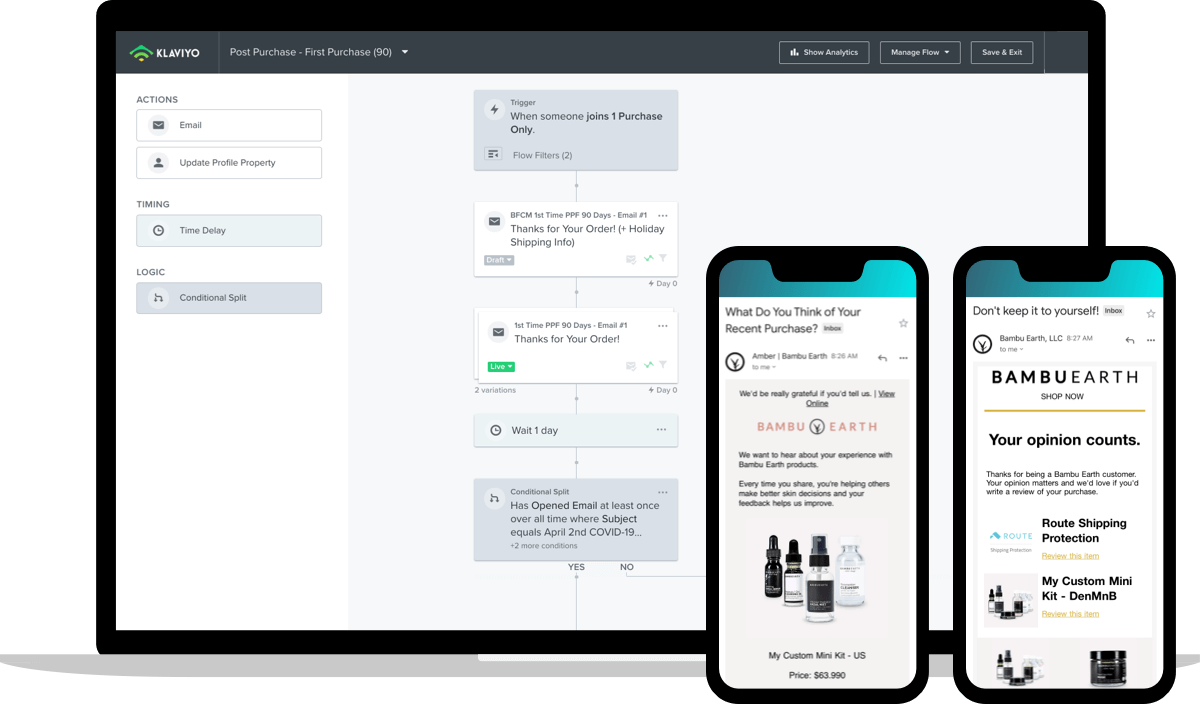
Once a product is delivered, solicit feedback from your customers about the product and purchase experience.
Positive reviews or testimonial videos can be powerful pieces of social proof that you can leverage in prospecting campaigns or to add conversion-driving content to your site or emails.
Negative reviews can be addressed via high-touch outreach from your customer service team, providing you the opportunity to make things right, winning back trust, and building the brand affinity necessary to sustain a long-term customer relationship.
Part 4. Minimize Your Variable Product Costs
While we all enjoyed ignoring expenses in ecommerce marketing for the better part of a decade, those days have ended.
Variable costs are now something that large and medium online stores need to consider. So, what’s a variable cost?
When costs increase as orders rise, that’s a variable cost (VC).
Opposed to fixed costs — like rent and operational overhead — VCs cover COGS, platform and payment processors, pick-and-pack, fulfillment, and CAC: total spend including agency fees.
Once again, we have a great whiteboard breakdown from Taylor for those who have a few minutes to check it out:
It’s an understatement to say the ecommerce industry has experienced a lot of volatility in variable costs as of late.
First, pandemic-triggered claims touting “a decade of ecommerce growth in one quarter” fell short. Though substantial, many of ecommerce’s gains have receded in the wake of retail’s return. Where COVID once lifted DTC’s tide, a new wave of competitors has rushed to crowd the waters.
Second, a slew of supply-chain issues have impacted even the world’s finest retailers. Leading to the first industry-wide down year in Black Friday, Cyber Monday history.
Third, iOS 14.5 smashed into Facebook advertising, decreasing ROAS by 30% virtually overnight.

How do you build a business that succeeds even when Facebook fails? More importantly, how do you thrive amid the pressure and chaos?
The answers lie in your variable costs.
10. Manage Variable Costs By Dividing Them into Four Categories
How do you measure and optimize variable costs?
There are plenty of ways, but we strongly recommend you follow a four-quarter accounting matrix. Each represents a portion of your revenue that signals the health of that component as well as areas of opportunity:
- Cost of Delivery or COGS
- Customer Acquisition Costs (CAC)
- Operating Costs (OPEX)
- Profit
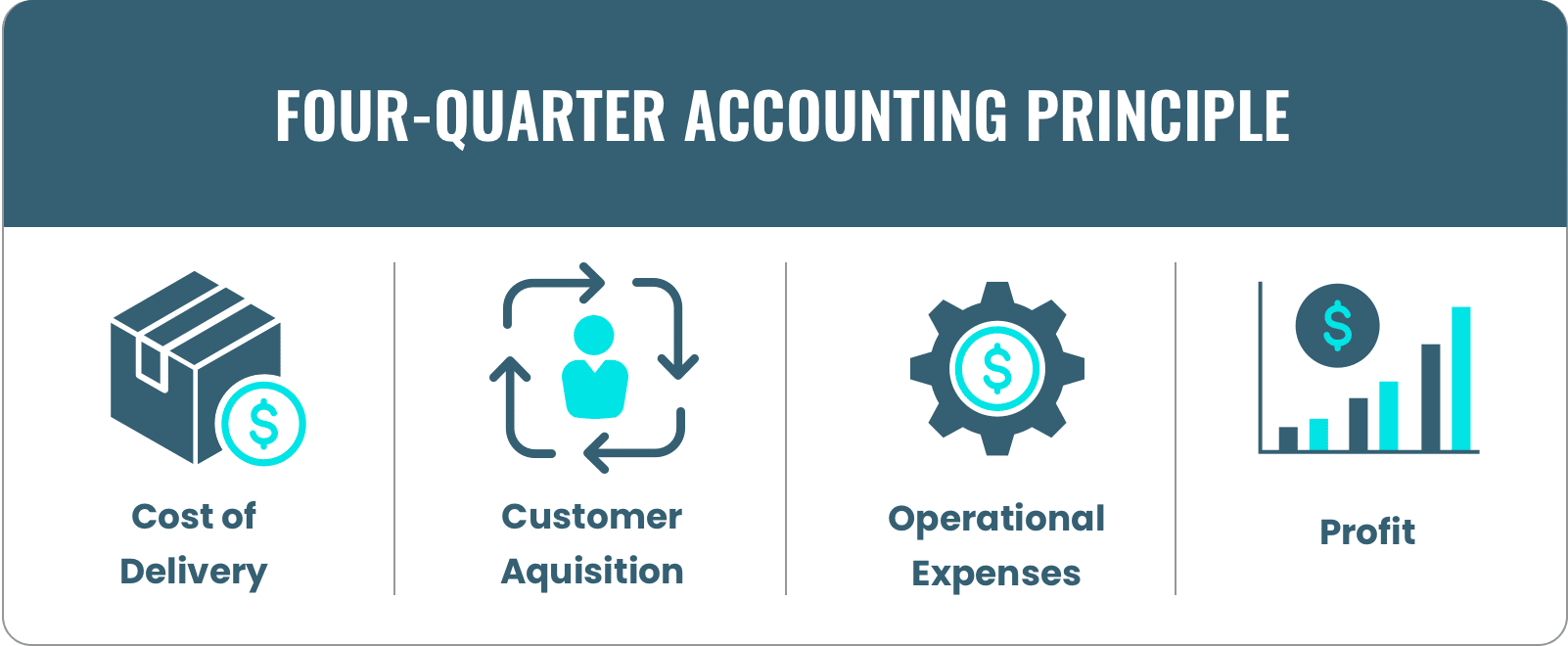
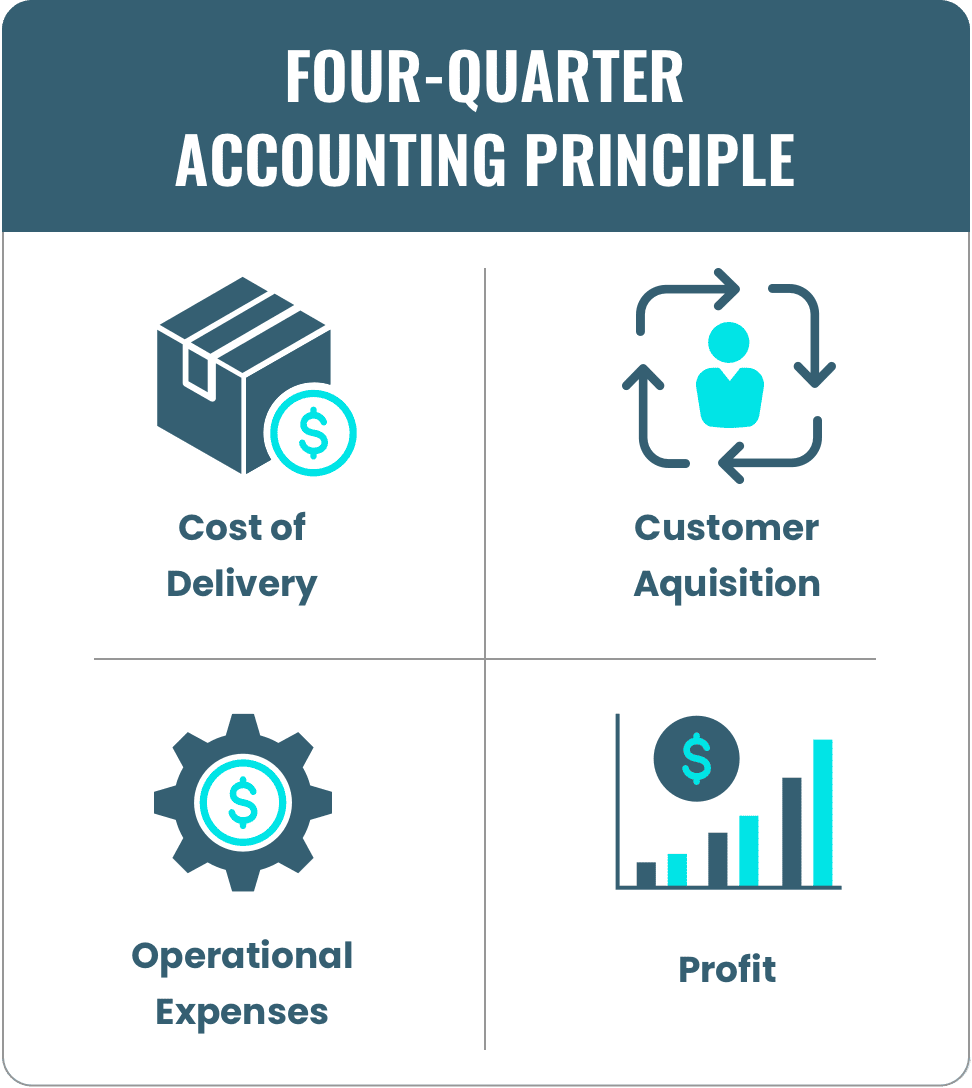
Ideally, aim at 25% of revenue going to each of these categories. Obviously, that’s a pretty high bar for profit, but it works better as a signal metric for our other categories.
Is CAC 25% or less? We’re going good there.
Are variables costs higher than 40%? That looks like an opportunity for improvement.
While OPEX is usually going to be out of our reach as growth marketers, we obviously have a lot of sway over CAC, and then Variable Costs are another area where we can help make a difference.
How do you improve these?
We can try to minimize packaging cost while still providing an exceptional unboxing experience. We can analyze how more expensive packaging impacts LTV (CM) and adjust around the best outcome.
We can push our team or clients to renegotiate their platform fees, payment processing fees, shipping costs, etc. Or, we can push our team or clients to renegotiate ingredient or materials pricing.
Simply put, there are numerous avenues to reduce variable costs, and we need to be looking for them.

Part 5. Profitability: What Does Your Ecommerce Marketing Plan Add Up To?
Regardless of your KPIs — whether they surround ecommerce marketing goals, online marketing efforts, or bottom-line numbers tied to your marketing budget — metrics can lead you astray if they are not put into context.
Where your typical digital marketing agency, ecommerce marketing agency, or even growth agency shapes its relationships around those metrics …
We define successful ecommerce marketing by dollars in your pocket.
Too many ecommerce businesses fall prey to the smokescreen of single-channel ROI targets.
Having every channel run at the highest-possible efficiency sounds great. But, a predictable series of behaviors emerge:
- Ad buyers push more and more budget toward remarketing
- Paid search buyers spends all their time (and all your money) on easy-win branded search campaigns
- Your email team focuses their efforts on pushing discounts to boost same-day sale revenue
Everyone’s return on investment (ROI) looks amazing. But, unfortunately, it’s a house of cards.
An equally predictable series of consequences follow:
- New customer acquisition crumbles
- Customer retention deteriorates
- Bottom-line revenue targets get missed
And, eventually, your business as a whole stops growing.
As entrepreneurs ourselves, we know what it’s like to hit these walls. But, we also know how to move past them.
The “common thread” we’ve found between successful brands is simple: they have a clear business goal and they know how to set targets that ladder up to that goal.
Understanding ecommerce growth means knowing how and why a given business makes money. And a marketing strategy is only effective when it’s tied to profit.
It’s the only way to translate big-picture goals into real-world outcomes.
We won't send spam. Unsubscribe at any time.

Matthew Axline is the Business Development Manager of Common Thread Collective. He's passionate about helping brand owners uncover the best eCommerce growth strategies for their business. Should you be curious as to what this entails, or you'd just like to talk shop, you can connect with him on LinkedIn or on Twitter.
